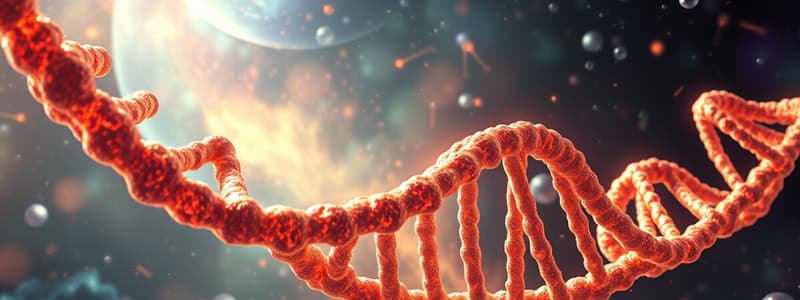Podcast
Questions and Answers
What significant evolutionary event does the endosymbiotic theory explain in relation to eukaryotes?
What significant evolutionary event does the endosymbiotic theory explain in relation to eukaryotes?
The endosymbiotic theory explains how eukaryotes originated from prokaryotic organisms, specifically the incorporation of alpha-proteobacteria as mitochondria and cyanobacteria as chloroplasts.
How do mitochondria and chloroplasts provide evidence for the endosymbiotic theory?
How do mitochondria and chloroplasts provide evidence for the endosymbiotic theory?
Both mitochondria and chloroplasts possess their own DNA and ribosomes similar to prokaryotic types, suggesting they were once free-living prokaryotes.
Describe the typical characteristics and advantages of eukaryotic cells compared to prokaryotic cells.
Describe the typical characteristics and advantages of eukaryotic cells compared to prokaryotic cells.
Eukaryotic cells are typically larger, possess a nucleus with linear chromosomes, have intracellular membranes, and are more complex with specialized compartments.
What are the implications of the presence of a cytoskeleton in eukaryotic cells?
What are the implications of the presence of a cytoskeleton in eukaryotic cells?
Identify the main groups classified under eukaryotes and their importance.
Identify the main groups classified under eukaryotes and their importance.
What role did RNA play in the early biochemical environment?
What role did RNA play in the early biochemical environment?
Describe the experiment conducted by Stanley Miller and Harold Urey in 1953.
Describe the experiment conducted by Stanley Miller and Harold Urey in 1953.
What characteristics define prokaryotic cells?
What characteristics define prokaryotic cells?
How did the accumulation of oxygen affect prokaryotic organisms?
How did the accumulation of oxygen affect prokaryotic organisms?
What is bacterial conjugation and its significance?
What is bacterial conjugation and its significance?
Explain the significance of LUCA in the evolutionary history of life.
Explain the significance of LUCA in the evolutionary history of life.
What are cyanobacteria and their unique characteristics?
What are cyanobacteria and their unique characteristics?
What is the function of enzymes secreted by prokaryotes during digestion?
What is the function of enzymes secreted by prokaryotes during digestion?
Flashcards are hidden until you start studying
Study Notes
Primitive Atmosphere and Organic Molecules
- Early Earth featured a primitive atmosphere allowing interactions of carbon and hydrogen.
- This enabled the formation of organic molecules through prebiotic and abiogenic synthesis.
- Formation of an "organic soup" occurred, filled with diverse chemical reactions.
Emergence of RNA
- RNA molecules influenced biochemical reactions and their own replication, leading to the "RNA world" hypothesis.
- RNA began catalyzing protein synthesis, marking it as the first biopolymer.
Stanley Miller and Harold Urey Experiment
- In 1953, Miller and Urey simulated early Earth conditions, leading to insights about organic compound formation.
Membrane Formation
- Lipids self-organized into bilayers, creating semi-permeable membranes for early cellular processes.
- This early membrane facilitated the import and export of substances without complex transport systems.
Genetic Information Storage
- DNA, being more stable than RNA, is the primary molecule for storing genetic information.
- Life traces back to a universal common ancestor (LUCA), existing around 4 billion years ago as an aerobic chemoautotroph.
Characteristics of Prokaryotes
- Prokaryotes are mostly unicellular, with sizes ranging from 1 to 10 µm.
- They have a lipid cell membrane and store genetic material in a circular DNA molecule located in the nucleoid.
- Prokaryotic cytoplasm contains ribosomes and plasmids; they lack a nucleus and membrane-bound organelles.
- Gram-negative bacteria possess a second outer lipid membrane for protection.
Prokaryotic Mobility and Dormancy
- Some bacteria are motile via flagella, while others can form resistant spores under extreme conditions.
- Cyanobacteria are photoautotrophs with pigment-containing membranes, representing an exception among prokaryotes.
Bacterial Conjugation and Cell Division
- Escherichia coli, a common gut bacterium, can transfer plasmids or chromosomal parts through a "protein tunnel."
- Bacterial cell division occurs via binary fission, where chromosomes segregate and new cell walls form.
Metabolism and Respiration
- As oxygen levels accumulated, many prokaryotes adapted to aerobic respiration.
- Electron transport chains and ATP synthase are located in their cell membranes.
Diversity of Prokaryotes
- Two major groups of prokaryotes: Bacteria (eubacteria) and Archaea (archaebacteria).
- Archaea thrive in extreme environments like hot springs and include ancestors of eukaryotes.
Characteristics of Eukaryotes
- Eukaryotes originated at least 2.7 billion years ago, larger in size (typically 10-100 µm).
- Possess a nucleus with linear chromosomes, enclosed intracellular membranes, and mitochondria.
- Eukaryotic flagella are structurally different from those of prokaryotes.
Nutrition and Reproduction in Eukaryotes
- Mostly aerobic heterotrophs, with some being photoautotrophs equipped with chloroplasts.
- Cell division occurs via mitosis, and sexual reproduction processes are common.
Endosymbiotic Theory
- Proposed by Ivan Wallin in the 1920s, explaining the origin of mitochondria and chloroplasts.
- Mitochondria are derived from alpha-proteobacteria, possess their own DNA, and ribosomes of prokaryotic type.
- Chloroplasts originated from cyanobacteria, which were ingested by ancient eukaryotes, eventually turning into chloroplasts.
Studying That Suits You
Use AI to generate personalized quizzes and flashcards to suit your learning preferences.




